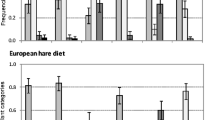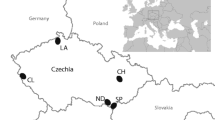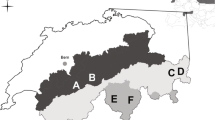Abstract
Foraging theory predicts that diet breadth should expand as food availability decreases. We tested this by looking at the winter browsing behaviour of the brown hare Lepus europaeus. We predicted selective feeding on different woody plant species, diet generalisation under increasingly severe winter conditions and a rank preference between the different food items. Following a period of severe winter conditions, we censused browsing marks of brown hares on woody plants at six sites situated at different altitudes (340-600 m a. s. I.) in Upper Franconia, Germany. We assumed that access to ground vegetation, which is the general diet of brown hares, was more restricted at sites with higher snow cover. The results provided support for all of our predictions: Feeding intensity varied strongly between the different plant species indicating selectivity of feeding. The number and also the percentage of browsed woody plant species was positively correlated with the altitude of the study site indicating a wider diet breadth in situations where less food was available. On the basis of a rank model on the food choice of brown hares, which was evaluated by an independent data set, we conclude that brown hares show a rank preference with regard to different groups of woody plant species. Our findings support the assumption that food restricted hares increasingly include unfavourable, low quality items into the diet.
Zusammenfassung
Nach Voraussagen der foraging theory sollte sich die Breite des Nahrungsspektrums bei abnehmender Nahrungsverfügbarkeit ausdehnen. Dies wurde von uns anhand von Daten zum Winterverbiß des Feldhasen Lepus europaeus untersucht. Unsere diesbezüglichen Erwartungen waren Selektivität in der Wahl verschiedener Gehölzarten, eine Erweiterung des Nahrungsspektrums bei zunehmender Winterhärte und eine Rangpräferenz zwischen den verschiedenen verbissenen Pflanzenarten. Unsere Studie wurde im Anschluß an eine extrem harte Winterperiode durchgeführt. Wir untersuchten Verbißstellen des Feldhasen an Gehölzarten in sechs verschiedenen Untersuchungsgebieten in verschiedenen Höhenlagen (340-600 m NN) in Oberfranken. Dazu setzten wir voraus, daß der Zugang zur Bodenvegetation, die grundsätzlich die Hauptnahrung des Feldhasen darstellt, in Gebieten mit höherer Schneelage stärker limitiert war. Unsere Ergebnisse stützen all unsere getroffenen Annahmen: die Verbißintensität der Feldhasen wies starke Unterschiede zwischen den verschiedenen Pflanzenarten auf, was auf eine selektive Nahrungswahl hindeutet. Weiterhin stand die Anzahl und auch der Anteil verbissener Gehölzarten in positivem Zusammenhang zur geographischen Höhe des Untersuchungsgebietes. Dies läßt auf ein verbreitertes Nahrungsspektrum unter Bedingungen der Nahrungslimitierung schließen. Anhand eines Rangmodells zur Nahrungswahl, das mit unabhängigen Daten evaluiert wurde, konnte auf eine lineare Rangpräferenz bezüglich verschiedener Gruppen von Gehölzarten geschlossen werden. Unsere Befunde stützen die Annahme, daß Feldhasen unter Bedingungen der Nahrungsverknappung zunehmend ungünstige Nahrung mit niedriger Qualität in ihre Ernährung einbeziehen.
Similar content being viewed by others
References
Arnold, G.W. (1981): Grazing behaviour. In: Grazing Animals, World Animal Science, Vol. BI. Ed. by F. H. W. Morley. Amsterdam: Elsevier. Pp. 79–104.
Broekhuizen, S.; Maaskamp, F. (1982): Movement, home range and clustering in the European hare (Lepus europaeus Pallas) in The Netherlands. Z. Säugetierkunde 47, 22–32.
Brown, D. T.; Doucet, G. J. (1991): Temporal changes in winter diet selection by white-tailed deer in northern deer yard. J. Wildl. Manage. 55, 361–376.
Brüll, U. (1976): Nahrungsbiologische Studien am Feldhasen in Schleswig-Holstein. Ein Beitrag zur Äsungsverbesserung. In: Ecology and Management of the European Hare Populations. Ed. by Z. Pielowski and Z. Pucek. Warszawa: Polish Hunting Association. Pp. 93–99.
Bryant, J. P.; Tahvanalnen, I.; Sulkinoia, M.; Julkunen-Tiitto, R.; Reichard, P. B.; Green, T. (1989): Biogeographic evidence for the evolution of chemical defense by boreal birch and willow against mammalian browsing. Am. Nat. 134, 20–34.
Bryant, J. P.; Kuropat, P. J. (1980): Selection of winter forage by subarctic browsing vertebrates: the role of plant chemistry. Ann. Rev. Ecol. Syst. 11, 261–285.
Cederlund, G. (1982): Mobility response of roe deer (Capreolus capreolus) to snow depth in a boreal habitat. Viltrevy 12, 37–68.
Clutton-Brock, T. H. (1977): Primate Ecology: Studies of feeding and ranging behaviour in lemurs, monkeys and apes. London: Academic Press.
Crawley, M. J. (1983): Herbivory: the dynamics of animal-plant interactions. Oxford: Black-well Scientific Publications.
Dearing, M. D.; Cork, S. (1999): Role of detoxification of plant secondary compounds on the diet breadth in a mammalian herbivore, Trichosurus vulpecula. J. Chem. Ecol. 25, 1205–1219.
Dearing, M. D.; Mangione, A. M.; Karasov, W.H. (2000): Diet breadth of mammalian herbivores: nutrient versus detoxification constraints. Oecologia 123, 397–405.
Emlen, J. M. (1966): The role of time and energy in food preferences. Am. Nat. 100, 611–617.
Farnsworth, K. D.; Illius, A. W. (1998): Optimal diet choice for large herbivores: an extended contingency model. Funct. Ecol. 12, 74–82.
Freeland, W. I.; Janzen, D. H. (1974): Strategies in herbivory by mammals: the role of secondary plant compounds. Am. Nat. 108, 269–289.
Frohne, D.; Jensen, U. (1998): Systematik des Pflanzenreichs. Stuttgart: Wissenschaftliche Verlagsgesellschaft.
Frylestam, B. (1986): Agricultural land use effect on the winter diet of brown hare (Lepus euro-paeus Pallas) in South Sweden. Mammal Rev. 16, 157–161.
Hiltunen, M. (2003): Feeding intensity of mountain hares (Lepus timidus) during winter in Finland. Mamm. biol. 68, 48–52.
Homolka, M. (1984): The diet of the brown hare (Lepus europaeus) in Central Bohemia. Folia Zool. 36, 103–110.
Iason, G. R.; Palo, R. T (1991): Effects of birch phenols on grazing and browsing mammals: a comparison of hares. J. Chem. Ecol. 17, 1733–1742.
Jessop, N. S.; Illius, A. W. (1997): Modelling animal response to plant toxicants. In: Handbook of Plant and Fungal Toxicants. Ed. by J. P. Felix D’Mello. Boca Raton: CRC Press. Pp. 243–253.
Kammerer, E. (1981): Bestimmung der Quantität und Qualität der aufgenommenen Äsung und Rückschlüsse auf die Größe des Tagesaktivitätsraumes des Feldhasen - Lepus europaeus Pallas - im Waldrevier (Raum Schrems). Diss. thesis, Veterinärmedizinische Universität Wien, Austria.
Kilias, FL.; Ackermann, W. (2001): Zur Bestandssituation des Feldhasen (Lepus europaeus Pallas) in Bayern. Z. Jagdwiss. 47, 111–124.
Kovács, G.; Büza, C. (1988): Characteristics of the home range of the brown hare (Lepus europaeus Pallas) in a forested and in a large-scale cultivated agricultural habitat. 1. Size of the home range. Vadbiologia 88, 67–84.
Krebs, J. R.; Stephens, D. W.; Sutherland, W. J. (1983): Perspectives in optimal foraging. In: Perspectives in Ornithology: essays presented for the centennial of the American Ornithologists’ Union. Ed. by A. H. Brush and G. A. Clark. Cambridge, New York: University Press. Pp. 165–216.
Levins, R.; MacArthur, R. H. (1969): An hypothesis to explain the incidence of monophagy Ecology 50, 910–911.
MacArthur, R. FL.; Pianka, E. R. (1966): An optimal use of a patchy environment. Am. Nat. 100, 603–609.
Mangan, J. L. (1988): Nutritional effects of tannins in animal feeds. Nutr. Res. Rev. 1, 209–231.
Mattson, W J. (1980): Herbivory in relation to plant nitrogen content. Ann. Rev. Ecol. Syst. 11, 119–161.
Mech, L. D., McRoberts, R. E., Peterson, R. O., Page, R. E. (1987): Relationship of deer and moose population to previous winters’ snow. J. Anim. Ecol. 56, 615–627.
Murray, M. G (1991): Maximizing energy retention in grazing ruminants. J. Ecol. 60, 1029–1045.
Novakova, E.; Vanek, J. (1956): Beitrag zur Kenntnis der Nahrungswahl des Hasen. Myslivost 2, 20.
Nudds, T. D. (1980): Forage ‘preference’: theoretical considerations of diet selection by deer. J. Wildl. Manage. 44, 735–740.
Oliver, J. E.; Hidore, J. J. (2001): Climatology: an atmospheric science. Upper Saddle River: Prentice Hall.
Onderschenka, K.; Tataruch, E. (1982): Ein Versuch zur Erstellung von Normalwerten wildlebender Tiere und die Anwendung dieser Daten in der Wildbiologie. Wiener Tierärztliche Monatsschrift 69, 274–279.
Palo, R.T.; Robbins, C. T (1991): Plant Defenses against Mammalian Herbivory. Boca Raton: CRC Press.
Pianka, E. R. (1994): Evolutionary Ecology. New York: Harper Collins.
Price, M. R. S. (1978): The nutritional ecology of Coke’s hartebeest (Alcelaphus buselaphus co-kei) in Kenya. J. Appl. Ecol. 15, 33–49.
Reitz, E.; Leonard, Y. (1994): Characteristics of European hare Lepus europaeus use of space in a French agricultural region of intensive farming. Acta Theriol. 39, 143–157.
Schmeil, O.; Fitschen, J. (2000): Flora von Deutschland und angrenzender Länder. Wie-belsheim: Quelle and Meyer Verlag.
Schoener, T. W. (1971): Theory of feeding strategies. Ann. Rev. Ecol. Syst. 2, 369–404.
Schreiber, R. (1997): Zur Vorlage von Proßholz für den ‘Waldhasen’ - ein Praxisexperiment. Beitr. Jagd-Wildforsch. 22, 173–180.
Sinclair, A. R. E.; Smith, J. N. K. (1984): Do plant secondary compounds determine feeding preference of snowshoe hares? Oecologia 67, 52–56.
Steineck, T. (1978): Die botanische Zusammensetzung des Mageninhalts von Feldhasen (Le-pus europaeus P.). Diss, thesis, Veterinärmedizinische Universität Wien, Austria.
Stevens, D. W.; Krebs, I. R. (1986): Foraging Theory. Monographs in Behavior and Ecology. New Jersey: Princeton University Press.
Telfer, E. S. (1972): Browse selection by deer and hares. J. Wildl. Manage. 36, 1344–1349.
Westoby, M. (1978): What are the biological bases of varied diets? Am. Nat. 112, 627–631.
Wetzel, J. F.; Wambaugh, J. R.; Peer, J. M. (1975): Appraisal of white-tailed deer winter habitats in northeastern Minnesota. J. Wildl. Manage. 39, 59–66.
Wirslng, A. J.; Murray, D. L. (2002): Patterns in consumption of woody plants by snowshoe hares in the northwestern United States. Ecoscience 9, 440–449.
Zörner, H. (1977): Ergebnisse der Untersuchung über die Ernährung des Feldhasen - Lepus europaeus (Pallas 1778) - im Wildforschungsgebiet Hakel. Beitr. Jagd-Wildforsch. 10, 255–266.
Author information
Authors and Affiliations
Corresponding author
Rights and permissions
About this article
Cite this article
Rödel, H.G., Völkl, W. & Kilias, H. Winter browsing of brown hares: evidence for diet breadth expansion. Mamm Biol 69, 410–419 (2004). https://doi.org/10.1078/1616-5047-00163
Received:
Accepted:
Published:
Issue Date:
DOI: https://doi.org/10.1078/1616-5047-00163




